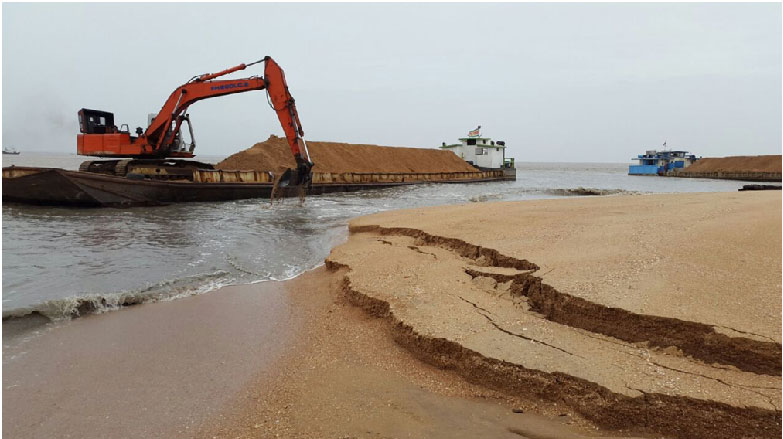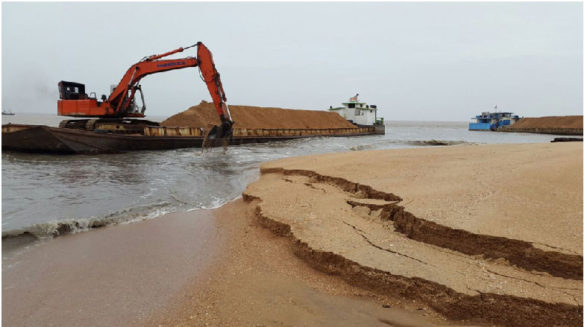
Four barges are currently mining shell sand at Braamspunt beach in Suriname, following a year-long ban of mining activities at the beach. This image was taken on March 9. Photo credit: Professor Sieuwnath Naipal.
By Rachel Fritts / Mongabay – Published under Creative Commons By NC-ND;(03-27-2017)
- Sand mining could decrease the ability of Braamspunt beach to protect Suriname’s capital city from rising sea levels and storms surges.
- Conservationists also fear for sea turtles nesting on the beach, which may be disturbed by the bright lights and loud noises of the industrial activity.
- Sand mining in coastal environments has become a global industry, threatening biodiversity and natural defenses against climate change.
When environmental activist Erlan Sleur heard that four sand mining barges had been spotted at Braamspunt beach, he dropped everything. Construction work on his house could wait.
“I wanted to go by boat to Braamspunt to see for myself what was true before I took action,” he said.
By the time he left, video footage of the sand mining had gone viral on social media, prompting an online petition. Four boatloads of people accompanied Sleur to protest at Braamspunt on February 18, two days after news broke of sand mining on the beach. Sand is a key component of concrete and asphalt, and coastal sand mining can be a cheap way to obtain this essential building material…
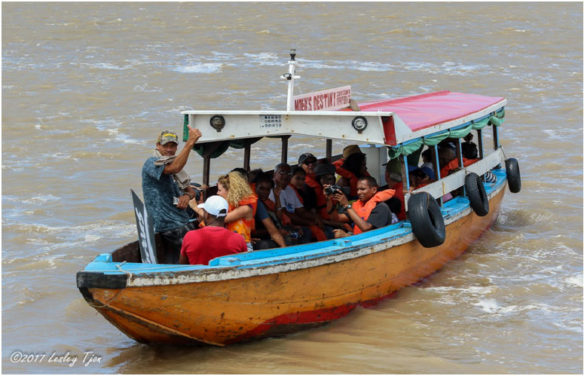
A boatload of people arriving at Braamspunt beach on February 18 to protest sand mining. Photo courtesy of Erlan Sleur, ProBioS.
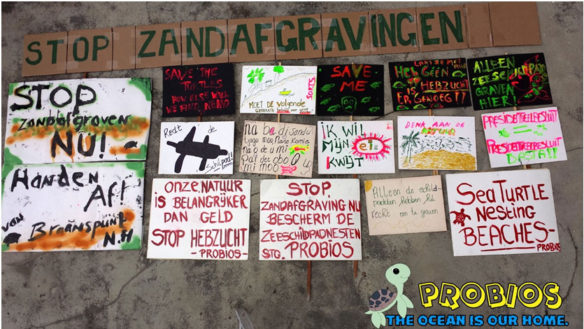
Signs from February 18 protest organized by ProBioS founder Erlan Sleur. Photo credit: Erlan Sleur, ProBioS.
The sand mining barges sighted at Braamspunt came as a shock to the public and to local NGOs alike. Sand mining had been banned at the beach since December 2015, and a 2016 WWF Guianas environmental impact report strongly recommended a permanent ban.
The report states that Braamspunt and other beaches on Suriname’s low-lying coast must stay intact to perform their role as a natural coastal defense system. Braamspunt’s proximity to capital city Paramaribo, home to 250,000 people, makes it especially important as a wave buffer. The beach also serves as a nesting ground for leatherback sea turtles (Dermochelys coriacea), listed as Vulnerable by the IUCN Red List, and green sea turtles (Chelonia mydas), considered Endangered.
Initially, the government appeared to comply with WWF Guianas’ recommendation. However, last month the Minister of Natural Resources Regilio Dodson issued mining permits to four Surinamese construction companies – NV Sarika, Gebroeders Soebratie NV, Rock & Dirt Shippers, and NV en Handelmij Dharmsing NV – to mine on the beach. While Dodson has claimed that WWF Guianas softened their recommendation during private talks in January, they deny this is the case.
“WWF adhered to the scientific recommendations that state that no sand mining should be done at Braamspunt,” Jerrell Pinas, a WWF Guianas representative, told Mongabay. He added that they “do not see the basis for misinterpretation.”
Minister Dodson was approached for comment but declined to respond.
Erlan Sleur’s environmental activism organization, Protect our Biodiversity in Suriname (ProBioS), and local NGOs such as the Green Heritage Fund, Conservation International Suriname, and WWF Guianas, are currently working together to push for the sustainable management of Braamspunt beach and Suriname’s natural resources – management that does not include sand mining.
The demand for sand
Far from being a local Surinamese problem, sand mining is a growing international concern. A recent article in the Guardian called it “the global environmental crisis you’ve never heard of.”
Sand is an invisible but essential building block in urban development. It is a key ingredient of glass, concrete, and roads. Over half of the world’s growing population lives in cities, and that percentage is expected to increase in coming years. The 40 billion metric tons of sand needed to prop up such unprecedented urban growth has to come from somewhere.
Previously, companies looked to land-based sources like quarries and riverbeds, but they are now turning to coasts and oceans to supply the world’s construction boom. Coastal sand mining has already destroyed some beaches and even entire islands.
“I think it’s always a bad option to mine on the coast,” said Pascal Peduzzi, a United Nations environmental program researcher and sand mining expert. Peduzzi said that sand mining risks coastal erosion, reducing protection from sea level rise and storm surges, and negatively impacting fisheries and coastal biodiversity.
These looming threats have already inspired protests and bans all around the world. But a sizeable and profitable sand mining black market has also arisen. In India, the “sand mining mafia” allegedly has enough wealth to bribe the government to turn a blind eye, according to activists in the country.
If sand mining continues unchecked the results could be devastating, warns Peduzzi.
“We still think that the world is infinite. Yes, there is a lot of sand, but it is not infinite.”
Where sand stands in Suriname’s coastal system
In Suriname, sand mining remains legal. However, sand is an integral part of the country’s coastal system, and removing significant amounts through mining, could have devastating consequences.
Suriname has a dynamic coast comprised of a number of mud banks that migrate westward, shrinking and expanding over time. In high wave energy areas between these mud banks, sand banks called “cheniers” rise up 2-4 meters above the muddy foundation, serving as natural flood protection and wave buffers. The mangroves sheltered by such cheniers then defend against coastal erosion.
This naturally occurring system of mud banks, cheniers, and mangroves provides a free protection service to the nearly half a million people who live along Suriname’s coast. But not everyone sees it that way.
“I think the common feeling is that we have a lot of mangroves,” said Sieuwnath Naipal, a Surinamese national and hydrologist at Anton de Kom University. If natural protections are stripped away and mangroves are destroyed, however, “you have to take over the protection and other functions of the mangroves by yourself, and then you have to pay for it.”
Currently, the government has no official plan for replacing vanishing natural coastal defenses. As most of the country’s inhabitants live near the coast, this could prove disastrous in light of climate change.
“Suriname is one of the top seven most endangered countries for sea level rise,” said Ramses Man of Conservation International Suriname. “It is a very low country, especially in the coastal area … If the sea level rises by one to two meters, then most of Paramaribo will be gone in 50 to 60 years.”
The chenier currently protecting Paramaribo and nearby mangroves is called Braamspunt.
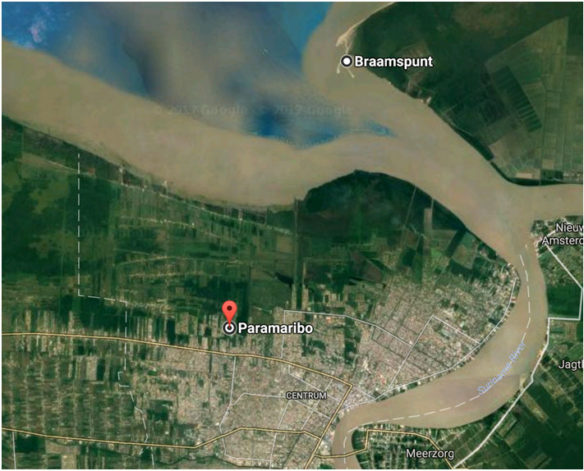
Braamspunt is a shell sand beach that sits on top of a mud flat at the mouth of the Suriname River. It serves as a wave breaker and flood defense for Paramaribo North. Photo credit: Google Earth.
The battle for Braamspunt
Just weeks after the beginning of the new year, Laurens Gomes, WWF Country Representative for Suriname, received a call. After a year-long ban, the Ministry of Natural Resources wanted to know how sand mining could begin again at Braamspunt without going against WWF Guianas’ recommendation. Gomes replied that the results of the impact report were unambiguous – any sand mining at all would cause significant damage.
In February, mining began again without WWF’s knowledge, timing that directly coincided with the beginning of Braamspunt’s sea turtle nesting season.
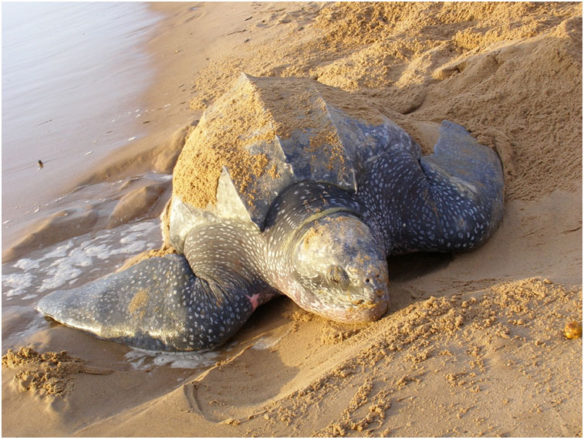
Braamspunt beach provides a nesting ground for a significant number of Atlantic leatherback sea turtles (Dermochelys coriacea). Photo credit: Jerrell Pinas, WWF Guianas.
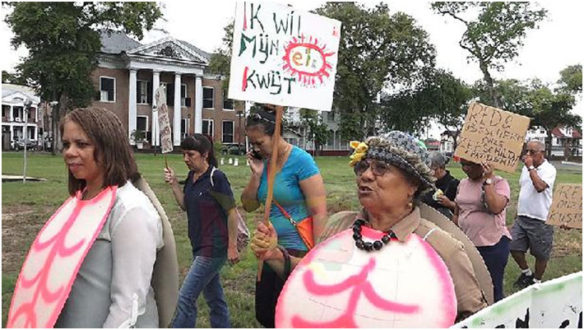
200 people demonstrated in front of Suriname’s Parliament building on February 24, in a protest organized by ProBioS. Some members of Parliament visited the beach themselves on the same day. Photo credit: Erlan Sleur, ProBioS…
Erlan Sleur has already organized two protests on the turtles’ behalf – the first, spontaneous protest on February 18, and a second involving 200 people on February 24 in front of Parliament.
He is not the only one concerned for the turtles’ safety.
While mining activities are currently to the west of turtle nesting grounds, Braamspunt’s size and shape are in a constant state of flux.
“We believe the population of marine turtles will rely more and more on the western part of the beach, at or very close to the mining activities,” said Pinas with WWF. “In the coming season or a next season, the options for nesting will be significantly limited due the mining impacts.”
Nesting female turtles and their hatching offspring might already be suffering ill effects.
“The fact that they [are] mining at night using big flood lights is already an important disturbance of the natural behavior of the sea turtles,” said Monique Pool, founder of the Green Heritage Fund. These concerns were echoed by Sleur and Conservation International Suriname.
At least seven nesting sea turtles have been found dead at or near Braamspunt since mining began.
The government has blamed the fishing industry for the turtles’ deaths. However, conservationists say the loud noises and bright lights of late-night mining activities can confuse adult and hatchling turtles, potentially driving them to exhaustion and increasing their risk of drowning and entanglement. More research is needed to understand the full effect of sand mining on turtle behavior.
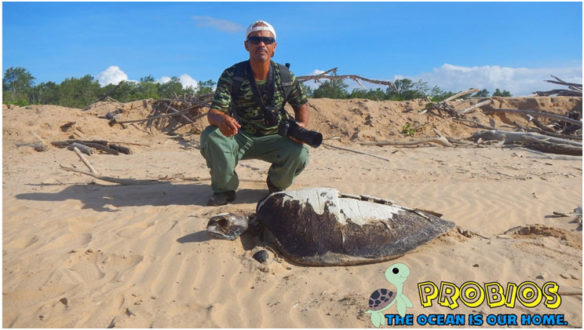
Dead green sea turtle (Chelonia mydas) found on Braamspunt beach on February 20. It had likely been dead for a week when it was discovered. Photo credit: ProBioS.
The way forward
Suriname’s NGOs hope to work out a sustainable solution that will be both economically and environmentally beneficial to all who depend on Braamspunt’s continued existence.
“If a government really is committed to sustainable development they should integrate and recognize the economic, environmental and social concerns of all stakeholders,” said Pool.
She stressed that ecotourism operators and fishermen who rely on Braamspunt’s biodiversity do not necessarily have other income options if the beach is destroyed.
“Sand mining could potentially harm a lot of people who live on very low incomes,” she warned.
Meanwhile, WWF Guianas, CI Suriname, and the Green Heritage Fund hope that the government will be open to exploring alternative materials or more sustainable locations to fill the construction industry’s sand demand.
“We don’t say that you cannot make any money on nature, but take the natural resources that are sustainable,” said CI Suriname’s Ramses Man. “Just think about what you take.”
Original Article And Learn More, Mongabay (03-27-2017)
Impacts of sand mining on beaches in Suriname; WWF (02-2016)
The goal of this report is to inform the Surinamese Government and Public on the impacts of sand mining on beaches in Suriname, based on the analysis of satellite images of the Suriname coast, and on ground observations on Braamspunt beach, and the necessity for conservation of beach sand budgets, beaches being a fundamental element of the coast of Suriname.
The battle for the Surinamese sand: turtle vs. construction industry; NOS- (Original Surinamese Dutch version) (02-20-2017)
More than a hundred activists left last Saturday to Braamspunt, the northernmost tip of the Suriname River, to protest against the excavations which began here again for a week in the sand tongue…
Sand Is in Such High Demand, People Are Stealing Tons of It, By Dave Roos; HowStuffWorks (03-06-2017)
As strange as it may sound, sand is one of the world’s hottest commodities. The global construction boom has created an insatiable appetite for sand, the chief ingredient for making concrete. The problem is that sand isn’t as abundant as it used to be. And when high demand and high value meets scarcity, you open the doors to smuggling…
The Conservation Crisis No One Is Talking About, By John R. Platt, TakePart (09-21-2016)
Beaches around the world are disappearing. No, the cause isn’t sea-level rise, at least not this time. It’s a little-known but enormous industry called sand mining, which every year sucks up billions of tons of sand from beaches, ocean floors, and rivers to make everything from concrete to microchips to toothpaste…
Sand, Rarer Than One Thinks: A UNEP report (GEA-March 2014)
Despite the colossal quantities of sand and gravel being used, our increasing dependence on them and the significant impact that their extraction has on the environment, this issue has been mostly ignored by policy makers and remains largely unknown by the general public.
In March 2014 The United Nations released its first Report about sand mining. “Sand Wars” film documentary by Denis Delestrac – first broadcasted on the european Arte Channel, May 28th, 2013, where it became the highest rated documentary for 2013 – expressly inspired the United Nations Environment Programme (UNEP) to publish this 2014-Global Environmental Alert.
Sand Thieves Are Eroding World’s Beaches For Castles Of Cash, by Martine Valo, Le Monde (09-2013)
The pillaging of sand is a growing practice in the world. This is because it represents 80% of the composition of concrete that it is the object of such greed…
Sand Wars, An Investigation Documentary, By Award-Winning Filmmaker Denis Delestrac (©-2013)
Is sand an infinite resource? Can the existing supply satisfy a gigantic demand fueled by construction booms? What are the consequences of intensive beach sand mining for the environment and the neighboring populations…? This investigative documentary takes us around the globe to unveil a new gold rush and a disturbing fact: the “Sand Wars” have begun…
Global Sand Mining: Learn More, Coastal Care
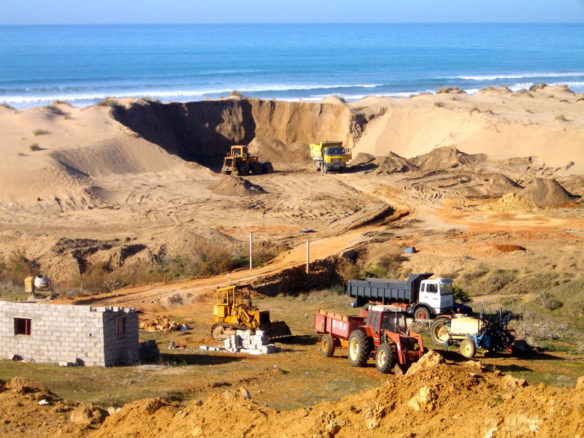
Photograph: © SAF — Coastal Care
As of 2011-2012, when investigative filmmaker Denis Delestrac and team, were first collecting and unveiling unpublished sand mining datas and information from the professionals involved, the Sand business was estimated to be a $70 billion industry, worldwide…!—Denis Delestrac (©-2013)
“Sand is the second most consumed natural resource, after water. The construction-building industry is by far the largest consumer of this finite resource. The traditional building of one average-sized house requires 200 tons of sand; a hospital requires 3,000 tons of sand; each kilometer of highway built requires 30,000 tons of sand… A nuclear plant, a staggering 12 million tons of sand…”—Denis Delestrac (©-2013), “Sand Wars” Multi Award-Winning Filmmaker.

